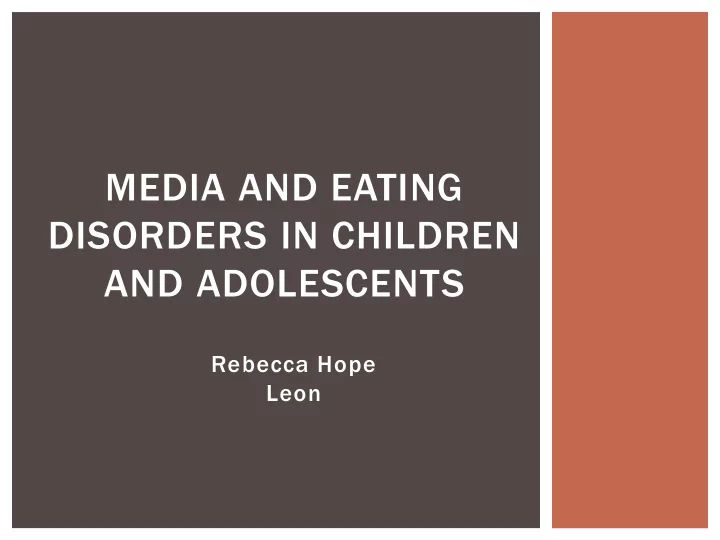

MEDIA AND EATING DISORDERS IN CHILDREN AND ADOLESCENTS Rebecca Hope Leon
BODY IMAGE Body image refers to how people see themselves Negative body image refers to an unrealistic view of how people perceive their bodies Body image concerns and eating disorders are inherently linked Often, it’s early dissatisfaction with a young person’s appearance that leads them to conclude that losing weight would enhance their appearance and make them feel better about themselves and their bodies
EATING DISORDERS Eating disorders are illnesses characterized by irregular eating habits and severe distress or concern about one’s body weight or shape These dangerous eating patterns include either inadequate food intake or excessive food intake, which can ultimately damage an individual’s health and well -being Though classified as biologically-based mental disorders, the exact cause of these afflictions is unknown It is generally believed that a combination of biological, psychological and/or environmental abnormalities contribute to the development of these illnesses
THE THIN IDEAL Notions of beauty involve shape, skin color, and even length of legs In America, beauty is defined by an unattainable cultural construct “Thin Ideal” deems thinness superior This sets an unrealistic and unattainable standard of beauty for young girls to aspire to
MAGAZINES AND NEGATIVE BODY IMAGE 69% of girls in 5 th -12 th grade reported that magazine pictures influenced their idea of a perfect body shape The average fashion model is 23% thinner than the average woman
THE AVERAGE AMERICAN WOMAN
MEDIA PORTRAYAL OF WOMEN
How do you think these images effect children and adolescents?
PSYCHOLOGICAL PROCESS OF DISORDERED EATING Body dissatisfaction, which can arise from comparing one’s body to images portrayed in the media, is the first important development in the symptomology of eating disorders As body dissatisfaction increases, self-esteem decreases, which often leads to a motivational response Motivational responses include dieting and engaging in eating disorder behavior
THE PROOF IS IN THE PUDDING 46% of 9-11 year- olds are “sometimes” or “very often” on diets Girls as young as middle school are preoccupied with the thin ideal as many of them try to look like the girls/women on TV or in magazines They are taught from a young age that they must attain a thin body through disordered eating https://www.youtube.com/watch?v=W0IX0ttybvo
With the rapid growth of eating disorders in society, whose responsibility do you think it is to prevent negative body image? Is it up to parents to teach their children about positive body image? What do you think the media can do to stop perpetuating unrealistic standards of beauty?
Recommend
More recommend